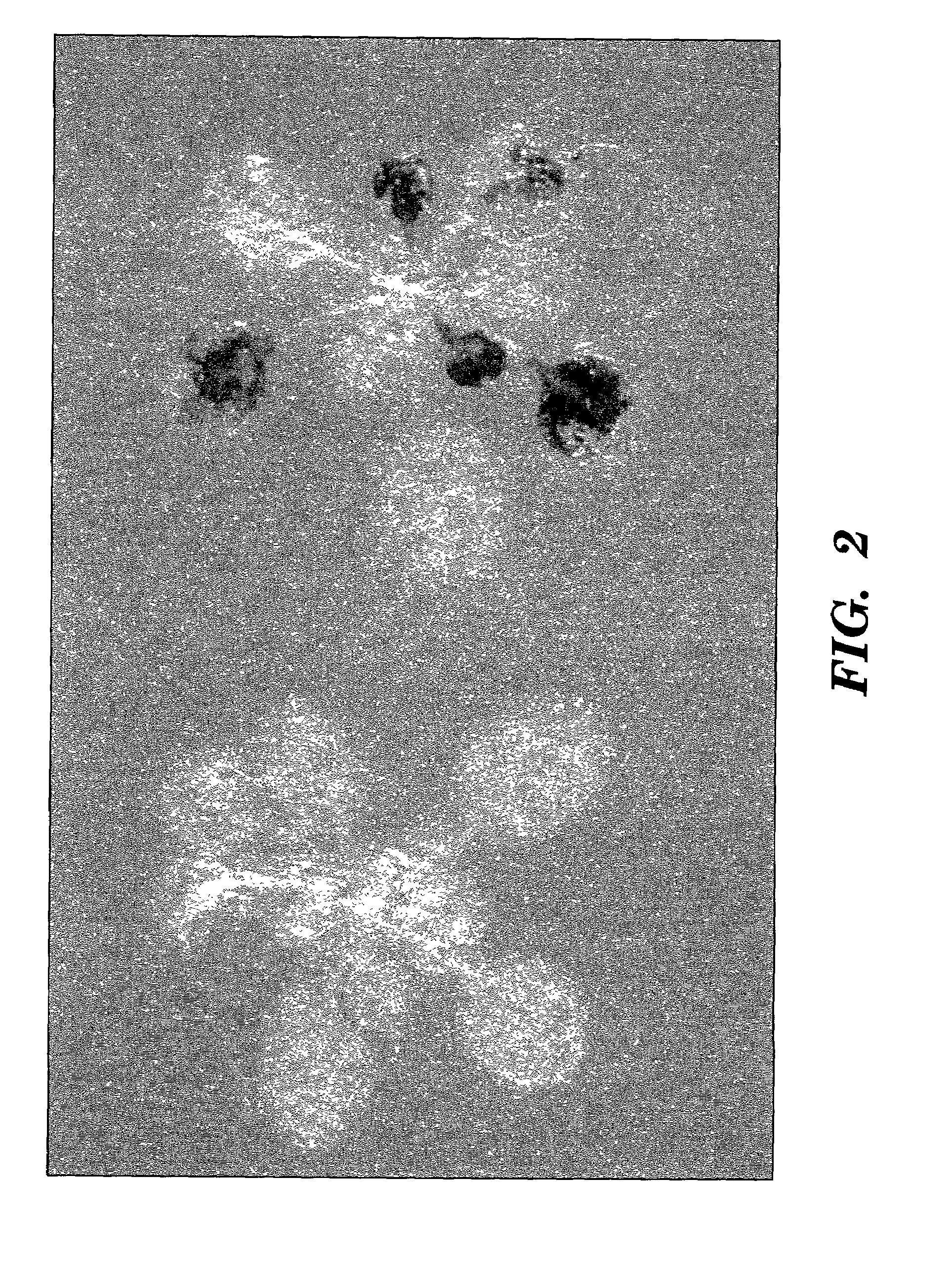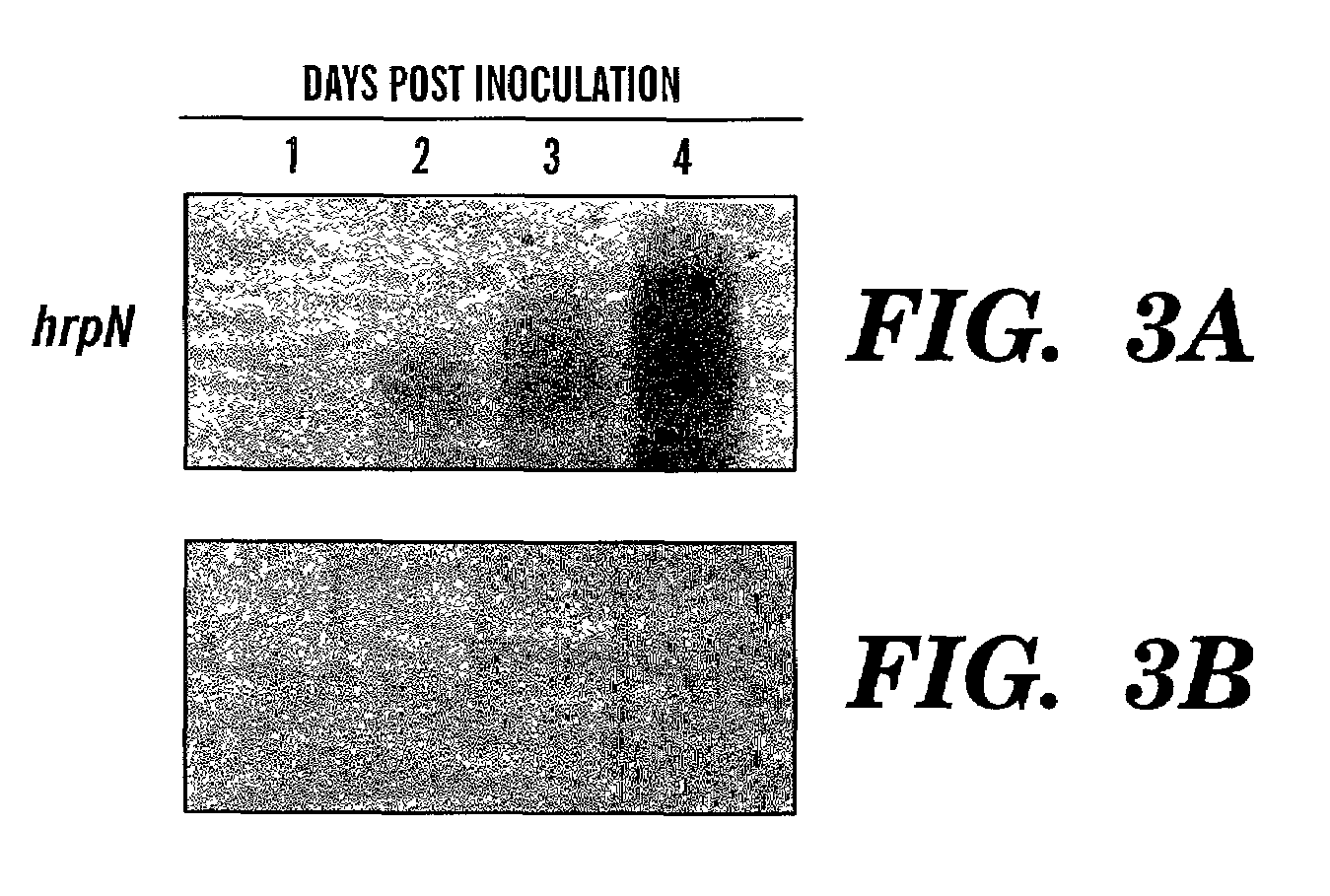Oomycete-resistant transgenic plants by virtue of pathogen-induced expression of a heterologous hypersensitive response elicitor
a heterologous, hypersensitive response technology, applied in the direction of biocide, peptides, genetic material ingredients, etc., can solve the problems of black shank, a highly destructive root and stem rot disease the loss of many varieties of cultivated tobacco, so as to induce systemic resistance
- Summary
- Abstract
- Description
- Claims
- Application Information
AI Technical Summary
Benefits of technology
Problems solved by technology
Method used
Image
Examples
example 1
Construction of Chimeric Gene
[0098]The gst1 promoter region from nucleotides (539 to +48) (Martini et al., “Promoter Sequences of a Potato Pathogenesis-related Gene Mediate Transcriptional Activation Selectively upon Fungal Infection,”Mol. Gen. Genet. 236 (2–3):179–86 (1993), which is hereby incorporated by reference), was PCR amplified using DNA from potato cultivar Atlantic, using a forward primer containing a BamHI site (SEQ. ID. No. 18) as follows:
[0099]
tgacggatcc taggaagttt cacttttggt gg32
a reverse primer containing an EcoRI site (SEQ. ID. No. 19) as follows:
[0100]
tagcgaattc tatgtgtggt tggtctccct tg32
and PrimeZyme DNA polymerase (Whatman Biometra, Goettingen, Germany). The DNA was ligated into the LITMUS 38 vector (New England Biolabs, Beverly, Mass.) and three clones were sequenced on an ABI 377 sequencer at the Cornell BioResource Center. Each clone had two to three nucleotide changes when compared to the published sequence (Martini et al., “Promoter S...
example 2
Inoculation With Peronospora parasitica Activates gst1 Transcription in Arabidopsis
[0113]To evaluate the activity of the gst1 promoter in a plant other than potato, transgenic Arabidopsis were constructed containing the E. coli uidA gene for β-glucuronidase (GUS) under control of the gst1 promoter. Histochemical GUS assays of were performed essentially as described by Martin et al., “The GUS Reporter System as a Tool to Study Plant Gene Expression,” in Gallagher, ed., GUS Protocols: Using the GUS Gene as a Reporter of Gene Expression, Academic Press, pp. 23–43 (1992), which is hereby incorporated by reference. Uninoculated and inoculated whole small Arabidopsis plants were submerged for 30 minutes on ice in six well microtiter plates in a solution of 1.5% freshly prepared paraformaldehyde in 100 mM sodium phosphate buffer, pH 7.2, containing 0.1% Triton X-100. The plants were washed twice for 5 minutes with sodium phosphate buffer pH 7.2. The plants were then submerged in a solutio...
example 3
Pathogen Inducible Expression of hrpN in Transgenic Arabidopsis
[0115]To generate transgenic Arabidopsis expressing hrpN in a pathogen-inducible manner, plant transformation vectors, pCPP 1292 for cytoplasmic localization of HrpN in plants, and pCPP 1294 for extracellular localization of HrpN, were constructed. (FIGS. 3A and 3B). Arabidopsis ecotype Columbia (Col-O) was transformed with the two constructs. Arabidopsis thaliana ecotype Columbia (Col-O) plants were grown in a growth chamber at 22° C. and a 17 hour photoperiod. Plants with primary fluorescence 5–15 cm tall were transformed via a known vacuum infiltration method (protocol available from Dr. Pamela Green of Michigan State University adapted from Bechtold et al., C. R. Acad. Sci. Paris 316:1194–1199 (1993), and Bent et al., Science 237:1856–1860 (1994), which are hereby incorporated by reference. Seeds were collected from each plant individually, sterilized and spread on selection plates containing 150 mg / l gentamycin, 0....
PUM
| Property | Measurement | Unit |
|---|---|---|
| molecular weight | aaaaa | aaaaa |
| molecular weight | aaaaa | aaaaa |
| temperature | aaaaa | aaaaa |
Abstract
Description
Claims
Application Information
 Login to View More
Login to View More - R&D
- Intellectual Property
- Life Sciences
- Materials
- Tech Scout
- Unparalleled Data Quality
- Higher Quality Content
- 60% Fewer Hallucinations
Browse by: Latest US Patents, China's latest patents, Technical Efficacy Thesaurus, Application Domain, Technology Topic, Popular Technical Reports.
© 2025 PatSnap. All rights reserved.Legal|Privacy policy|Modern Slavery Act Transparency Statement|Sitemap|About US| Contact US: help@patsnap.com



